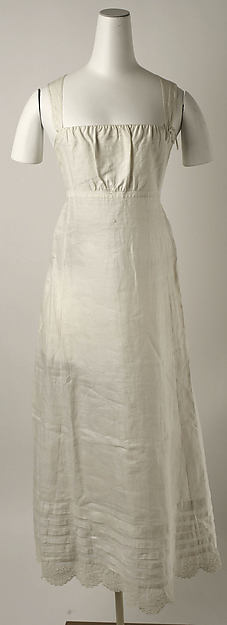
Well, all three of my dear followers, you get another post.
Last night I finished my Regency bodiced petticoat and took some photos. They're really horrible quality photos, due to my not owning a better camera than the one in my phone, but you'll get an idea, at least.
This is a continuation of the HSF's January "Foundations" challenge, and is part of the ensemble for the 1815 ball gown (Deadline for that: February 13).
The bodiced petticoat is loosely based on this one, from the Met (left), although I did not slavishly recreate it. My fabric was cotton gauze, instead of stiffer linen, and I wanted the waistline low enough that it will allow for a slim-fitting gown in front (ie, no extra fabric there to force the skirts outwards - I want them to hang close to the waist for as long as they can) but contribute to volume in the back (ie, lots of pleats). I also ignored the tucks at the bottom, because I didn't have enough yardage, and the lace, because I don't really have time for extra bits right now. However, overall, the construction and shape are the same as the museum piece. It's more a corset cover than anything; the gauze is too flimsy to do much in the way of shaping the heavier fabrics that will go over top. My underdress will have a stronger constitution, with a slightly higher waistline and tucks for bottom volume.
Anyways, here it is, worn over my new short stays and my *cough*1850s-60s*cough* chemise. Again, sorry for the awful photo quality, and also for the black pants underneath - it's all a bit see-through.
.jpg)
%2Bcopy.jpg)
It's held together with a tie at the back waist and two sets of hooks and eyes. The original has self-fabric buttons, by the looks of things, but hooks and eyes have less bulk and I really didn't fancy the prospect of making buttons out of the gauze.
The back panel is 30-some inches wide with a little placket at CB, and all that length is pleated into the space between the two side-back seams, so lots of volume there. I also went with a pretty deep V in back because I'm not yet sure how low the back neckline of my ball gown will be.
This petticoat could work for 1820s or even early 1830s gowns, too, which is nice. I like versatility in my foundation pieces.
On to the undergown!
%2Bcopy.jpg)
.jpg)
Hi! I'll follow you since you're following me. :) I made a bodiced petticoat using the drawstring bodice from my LaMode Bagatelle pattern. The bones on the side of the bust portion give you the support you need and by tightening the drawstrings around the neckline and under the bodice you get a great bust "shelf" for Regency. I think what you have there is just a petticoat because the bodiced one is used in place of the corset. But beautifully done!
ReplyDeleteVal PS, I just added the photos of mine to my last blog post since I'd forgotten it until I read your post.
Hmmm, I had assumed that the 'bodiced' portion merely referred to the fact that it has a bodice attached rather than simply tying around the waist like earlier and later pettis, or having bare-minimum shoulder straps. Thanks for the info! I don't think I will add bones in this one, as I really don't need more boning with the stays underneath. The stays and petti can both be worn higher to create the bust shelf, but I actually prefer the later silhouette and wanted these pieces to be versatile. =)
Delete